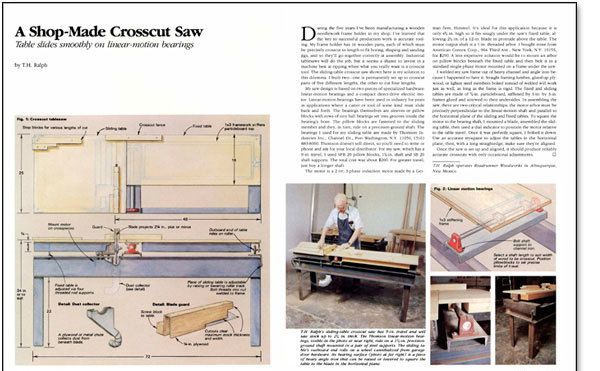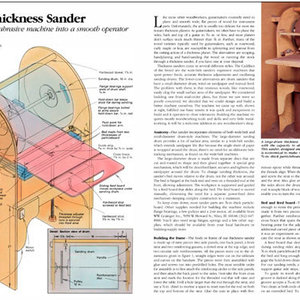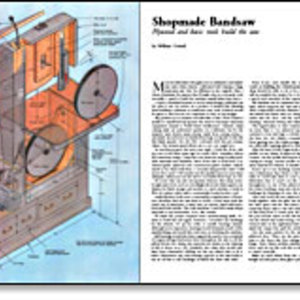A Shop-Made Crosscut Saw
Table slides smoothly on linear-motion bearings
Synopsis: During the five years I’ve been manufacturing a wooden needlework frame holder in my shop, I’ve learned that the key to successful production work is accurate tooling. My frame holder has 14 wooden parts, each of which must be precisely crosscut to length to fit boring, shaping and sanding jigs, and so they’ll go together correctly at assembly. Industrial tablesaws will do the job, but it seems a shame to invest in a machine best at ripping when what you really want is a crosscut tool. The sliding-table crosscut saw shown here is my solution to this dilemma. I built two—one is permanently set up to crosscut parts of five different lengths, the other to cut four lengths.
During the five years I’ve been manufacturing a wooden needlework frame holder in my shop, I’ve learned that the key to successful production work is accurate tooling. My frame holder has 14 wooden parts, each of which must be precisely crosscut to length to fit boring, shaping and sanding jigs, and so they’ll go together correctly at assembly. Industrial tablesaws will do the job, but it seems a shame to invest in a machine best at ripping when what you really want is a crosscut tool. The sliding-table crosscut saw shown here is my solution to this dilemma. I built two-one is permanently set up to crosscut parts of five different lengths, the other to cut four lengths.
My saw design is based on two pieces of specialized hardware: linear-motion bearings and a compact direct-drive electric motor. Linear-motion bearings have been used in industry for years in applications where a cutter or tool of some kind must slide back and forth. The bearings themselves are sleeves or pillow blocks with rows of tiny ball bearings set into grooves inside the bearing’s bore. The pillow blocks are fastened to the sliding member and they, in turn, ride on a precision-ground shaft. The bearings I used for my sliding table are made by Thomson Industries Inc., Channel Dr., Port Washington, N .Y. 1 1050, (516) 883-8000. Thomson doesn’t sell direct, so you’ll need to write or phone and ask for your local distributor. For my saw, which has a 9-in. travel, I used SPB 20 pillow blocks, 1 1/4-in. shaft and SB 20 shaft supports. The total cost was abollt $200. For greater travel, just buy a longer shaft.
The motor is a 2-HP, 3-phase induction motor made by a German firm, Himmel. It’s ideal for this application because it is only 4 3/4 in. high so it fits snugly under the saw’s fixed table, allowing 2 1/4 in. of a 12-in. blade to protrude above the table.
For the full article, download the PDF below:


















Log in or create an account to post a comment.
Sign up Log in